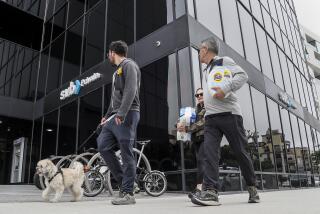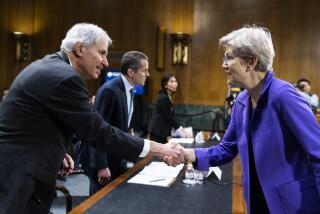Seidman Puts S&L; Bailout at $500 Billion
WASHINGTON â L. William Seidman, chairman of the Federal Deposit Insurance Corporation, said Monday that the S&L; bailout probably will end up costing âmuch in excess ofâ $500 billion--partly because the recent slump in the real estate market will push more thrifts over the financial edge.
Seidmanâs figures, provided during a television interview, are the highest estimate by any government official so far of the total cost of the S&L; rescue effort. Private forecasters have been using such figures for months.
Previously, the most pessimistic assessment by a government agency had come from Congressâ General Accounting Office, which predicted a few weeks ago that the bailout effort would cost between $325 billion and $400 billion over the next 30 years.
Also on Monday, Seidman appeared with Treasury Undersecretary Robert R. Glauber before the House Banking, Finance and Urban Affairs Committee. The two officials told the committee that Congress will have to authorize an additional $50 billion for the Resolution Trust Corporation--set up to oversee the S&L; rescue--to cover escalating bailout costs next year.
They estimated that the Resolution Trust Corporation would also need an additional $50 billion to $60 billion in borrowing authority next year.
Those loans eventually would be paid back from profits from trust corporation sales of real estate and other assets of the failed thrifts.
Glauber said the need for new money is so urgent that lawmakers may have to authorize $5 billion to $10 billion immediately--to get the agency through January and February--and then approve the rest in the new year.
Separately, Sen. Howard M. Metzenbaum (D-Ohio), chairman of a Senate Judiciary subcommittee that is investigating the S&L; crisis, said in a statement that a prominent lobbyist accused of helping arrange questionable S&L; deals has rejected his panelâs subpoena to testify.
Metzenbaum said that, if lobbyist Robert Thompson does not change his mind and cooperate, the subcommittee will seek to enforce the subpoena through the courts. Thompson allegedly helped James Fail, an Arizona businessman, use federal subsidies to acquire Bluebonnet S&L.;
Seidmanâs off-the-cuff estimate of $500 billion or more includes the interest that the government is likely to have to pay on the amount it will have to borrow to finance the S&L; rescue. He put the actual cost of the bailout itself at between $175 billion and $200 billion.
The Bush Administration continues to hew to a far lower estimate of the cost of the S&L; bailout. Treasury officials place the likely cost at between $93 billion and $130 billion, not including interest. They reiterated that forecast Monday.
However, most analysts regard those estimates as already out of date.
The FDIC chief said in the interview on ABCâs âGood Morning Americaâ that at least part of the sharp increase from previous government estimates reflects the fact that the governmentâs initial forecasts were based on figures provided by the thrifts themselves, âand they simply werenât accurate.â
But he said the increase also reflects the fact that real estate values have gone down sharply in recent months, while interest rates have risen--pushing the total costs of the whole operation steadily higher.
âEverything has gone the wrong way,â he said in the TV appearance.
Seidman said that he expects the government to take over between 300 and 400 more insolvent S&Ls; on top of the more than 400 institutions that it has acquired so far.
âWeâre closing them down every day, so those numbers change daily,â he added.
Seidman conceded that the S&L; bailout has become a major political issue. âThis is the largest financial debacle in the history of the United States,â he said. âI think the taxpayers are going to be very interested in . . . who is at fault.â
Seidmanâs higher estimates and the request for more money and increased borrowing authority for the Resolution Trust Corporation drew sharp criticism from committee members, who demanded that the government take tougher enforcement action against directors of the insolvent thrifts.
Rep. Frank Annunzio (D-Ill.), once viewed as a staunch supporter of the S&L; industry, demanded that enforcement officials initiate more lawsuits and prosecutions. Seidman said that suits currently are pending against about 500 S&L; directors and that 1,000 more cases are under review.
Seidman said that the FDIC will decide âin the reasonably near futureâ whether to sue Neil Bush and other officers of Silverado Banking, Savings & Loan Assn. in Denver.
Bush, one of President Bushâs sons, and other Silverado officers could be found liable for a part of the $1-billion loss taxpayers suffered in the institutionâs collapse.
Rep. Mary Rose Oakar (D-Ohio) asked why it is not against the law for defunct S&Ls; to provide generous retirement benefits and bonuses for their officers. Seidman said that such a prohibition was stricken from the S&L; enforcement law enacted in 1989.
Rep. Toby Roth (R-Wis.) predicted that Congress would refuse to go along with more money for the S&L; bailout.
More to Read
Inside the business of entertainment
The Wide Shot brings you news, analysis and insights on everything from streaming wars to production â and what it all means for the future.
You may occasionally receive promotional content from the Los Angeles Times.










